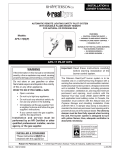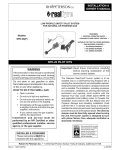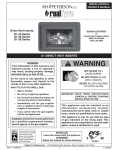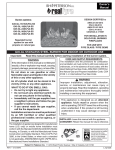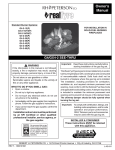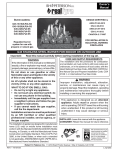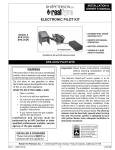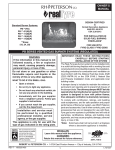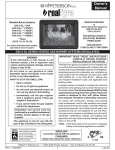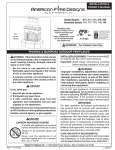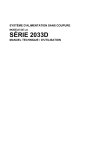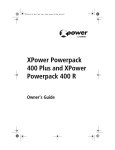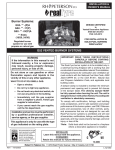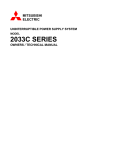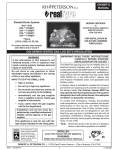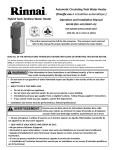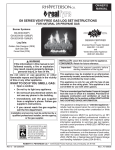Download Installation Manual
Transcript
INSTALLATION & OWNER’S MANUAL Direct Vent Inserts: D1-30 Series DESIGN CERTIFIED to Vented Gas Fireplace Heater ANSI Z21.88-2009 CSA 2.33-2009 D1 DIRECT VENT INSERTS WARNING WARNING If the information in this manual is not followed exactly, a fire or explosion may result, causing property damage, personal injury, or loss of life. HOT GLASS WILL CAUSE BURNS. DO NOT TOUCH GLASS UNTIL COOLED. Do not store or use gasoline or other flammable vapors and liquids in the vicinity of this or any other appliance. NEVER ALLOW CHILDREN TO TOUCH GLASS. WHAT TO DO IF YOU SMELL GAS: • Open a window. IMPORTANT: READ THESE INSTRUCTIONS CAREFULLY BEFORE STARTING INSTALLATION OR USE. • Do not try to light any appliance. • Do not touch any electrical switch; do not use any phone in the building. • Immediately call the gas supplier from a neighbor’s phone. Follow gas supplier’s instructions. • If you cannot reach the gas supplier, call the fire department. This appliance may be installed in an aftermarket, permanently located, manufactured home (USA only) or mobile home, where not prohibited by local codes. Installation and service must be performed by a qualified professional installer, service agency, or the gas supplier. This appliance is only for use with the type of gas indicated on the rating plate. This appliance is not convertible for use with other gases, unless a certified kit is used. INSTALLER: Leave this manual with the appliance. CONSUMER: Retain this manual for future reference. 12-051 Robert H. Peterson Co. • 14724 East Proctor Avenue • City of Industry, CA 91746 REV 0 - 1211051330 1 L-A2-344 INSTALLATION ET MODE D'EMPLOI Direct Vent Inserts: D1-30 Série CONCEPTION CERTIFIÉE à Réchauffeur exhalé de cheminée de gaz ANSI Z21.88-2009 CSA 2.33-2009 D1 INSERTS À ÉVACUATION DIRECTE AVERTISSEMENT AVERTISSEMENT Si l’information en ce manuel n’est pas suivie exactement, une incendie ou une explosion peut résulter, entraînant des dégats matériels, des blessures, ou la perte de la vie. UNA SURFACE VITRÉE CHAUDE PEUT CAUSER DES BRÛLURES. LAISSER REFROIDIR LA SURFACE VITRÉE AVANT D'Y TOUCHER. NE PERMETTEZ JAMAIS À UN ENFANT DE TOUCHER LA SURFACE VITRÉE. Ne stockez pas ou n’employez pas l’essence ou d’autres vapeurs et liquides inflammables à proximité de ceci ou d’aucun autre appareil. CE QUI À FAIRE SI VOUS SENTEZ LE GAZ: • Ouvrez une fenêtre. • N’essayez pas de n’allumer aucun appareil. • Ne touchez aucun commutateur électrique; n’utilisez aucun téléphone dans le bâtiment. • Appelez immédiatement le fournisseur de gaz du téléphone du voisin. Suivez les instructions du fournisseur de gaz. • Si vous ne pouvez pas atteindre le fournisseur de gaz, appelez le département de feu. IMPORTANT: L I S E Z C E S I N S T RU C T I O N S SOIGNEUSEMENT AVANT DE COMMENCER L'INSTALLATION OU L'UTILISATION. Cet appareil peut être installé dans un marché des accessoires, une maison de manière permanente située et manufacturée (Etats-Unis seulement) ou une caravane résidentielle, où non interdit par des codes locaux. L’installation et le service doivent être assurés par un installateur qualifié et professionnel, l’agence de service, ou le fournisseur de gaz. Cet appareil sert seulement avec le type de gaz indiqué de la plaque de contrôle. Cet appareil n'est pas convertible pour l'usage avec d'autres gaz, à moins qu'un kit certifié soit employé. INSTALLATEUR : Laissez ce manuel avec l'appareil. CONSOMMATEUR: Maintenez ce manuel pour la future référence. 12-051 Robert H. Peterson Co. • 14724 East Proctor Avenue • City of Industry, CA 91746 REV 0 - 1211051330 2 L-A2-344 TABLE OF CONTENTS USE, CARE, & SERVICE GETTING STARTED IMPORTANT PRE-INSTALLATION AND SAFETY INFORMATION .............................................................. 5 LIGHTING INSTRUCTIONS ......................................29 FOR YOUR SAFETY READ BEFORE LIGHTING......29 INTERMITTENT PILOT MODE AND STANDING PILOT MODE .........................................................29 LISTING AND CODE APPROVALS ............................. 7 LISTING ................................................................... 7 CODE REQUIREMENTS ........................................... 7 COMMONWEALTH OF MASSACHUSETTS REQUIREMENTS ...................................................... 7 REMOTE LIGHTING...............................................31 SPECIFICATIONS AND DIMENSIONS ....................... 8 REMOTE OPERATING INSTRUCTIONS ..................35 MINIMUM CLEARANCES TO COMBUSTIBLES ... 11 ORIENTATION ........................................................35 REPLACEMENT PARTS LIST ....................................12 THERMOSTAT ........................................................35 INSTALLATION REQUIREMENTS ...........................16 SET TEMPERATURE (Thermostat Modes Only).........37 FIREPLACE REQUIREMENTS ................................16 FLAME HEIGHT.....................................................37 GAS PRESSURE REQUIREMENTS ..........................16 FAN ........................................................................37 VENTING REQUIREMENTS ....................................17 ACCENT LIGHT (AUX) ...........................................37 MANUAL LIGHTING...............................................33 SHUTTING DOWN..................................................33 ACCENT LIGHT ONLY (NO FLAME) .......................37 INSTALLATION SECONDARY (REAR) BURNER ...............................39 INSTALLATION ...........................................................18 TEMPERATURE INDICATOR (˚F or ˚C) ...................39 BEFORE YOU BEGIN .............................................18 KEY LOCK .............................................................39 GAS SUPPLY SETUP ..............................................18 OPERATING DURING A POWER OUTAGE .............39 ELECTRICAL SETUP ..............................................18 SERVICING AND CLEANING ...................................41 VENTING ...............................................................19 ANNUAL CLEAN / INSPECTION .............................41 DIRECT VENT INSERT ...........................................20 GLASS PANEL REMOVAL AND MAINTENANCE ......42 INSTALL BATTERIES ..............................................21 PILOT BURNER CHECK/ADJUSTMENT .................42 FIRST TIME PILOT/BURNER LIGHTING TEST........22 AIR SHUTTER ADJUSTMENT .................................43 GAS PRESSURE TEST .............................................22 BATTERY REPLACEMENT ......................................44 REFRACTORY PANELS ...........................................23 SYNCHRONIZE REMOTE SYSTEM ..........................44 GLOWING EMBERS ...............................................24 LIGHT BULB REPLACEMENT ................................45 LOG SET ................................................................25 FUEL CONVERSION KITS ......................................45 GLASS PANEL.........................................................27 TROUBLESHOOTING ................................................46 SURROUND AND SCREEN .....................................27 WARRANTY .................................................................48 IMPORTANT SAFETY INFORMATION Congratulations on your purchase of an R. H. Peterson Co. Real Fyre gas fireplace insert. Made with pride in America, your new gas insert complies with national safety standards and when installed per these instructions and used as intended it will provide warmth and comfort to your home for many years. Due to the extreme heat output of the gas insert, there is a risk of burns if care is not taken in the operation of the unit. PLEASE READ THE SAFETY AND OPERATON INFORMATION AND WARNINGS IN THIS MANUAL BEFORE USING YOUR INSERT. Be aware that glass panels and other surfaces get extremely HOT and can cause burns if touched. Factory-provided barrier screens help to reduce the risk of serious burns as they can prevent direct contact with the glass. However, barrier screens still retain heat and must not be touched. The gas insert glass and surrounding material will remain HOT for a period of time after the unit is turned off, so caution should be used at all times. Refer to all safety information and warnings provided in this manual. REV 0 - 1211051330 3 L-A2-344 L'INFORMATION IMPORTANTE DE PRÉINSTALLATION ET DE SÛRETÉ AVERTISSEMENT! A. Lisez toutes les instructions. Ne pas installer ou utiliser cet appareil sans avoir lu et compris ce manuel. Ne pas suivre les instructions de ce manuel annulera la garantie et peut être dangereuse. B. Le non respect de ces instructions d'installation se traduira par un appareil mal installé et fonctionne, ce qui annulera sa garantie. Toute modification apportée à cet appareil et / ou de ses contrôles de fonctionnement est dangereux. C. Instructions à la terre électrique - Cet appareil est équipé d'un à trois broches (mise à la terre) pour vous protéger contre les chocs électriques et doit être branchée directement dans une prise à trois broches prise. Ne pas couper ou enlever la broche de terre de cette fiche. D. Ne pas placer les pièces conformément à ce manuel ou de l'échec d'utiliser seulement les pièces approuvées pour cet appareil peut entraîner des dommages matériels ou des blessures corporelles. E. Installation, maintenance et de réparation doit être effectuée par un technicien de service professionnel qualifié. F. Un inspecteur en bâtiment local devriez revoir vos plans avant l'installation. G. Une mauvaise installation, de réglage, la modification, un service ou d'entretien peut causer des blessures ou des dommages matériels. Reportez-vous à ce manuel. Pour de l'aide ou des renseignements supplémentaires, consultez un installateur qualifié, une agence de service ou le fournisseur de gaz. H. Une mauvaise installation ou l'utilisation de cet appareil peut causer des blessures graves ou la mort du feu, des brûlures, une explosion ou intoxication au monoxyde de carbone. I. Soyez extrêmement prudent lors de la manipulation de ce produit et ses accessoires car ils ont des bords tranchants qui peuvent causer des blessures. J. Il est recommandé que les détecteurs de fumée sont installés dans la maison. Si possible, installez un détecteur dans un couloir adjacent à la salle (pour éviter une fausse alarme de la chaleur de l'appareil). Cependant, vous devez suivre les exigences du code local. K. Toute modification ou altération peut annuler la garantie, la certification et les annonces de cet appareil. L. Dispositions pour la combustion adéquate et l'air de ventilation doit être maintenue. M. Dégagements d'accessibilité adéquats pour l'entretien et doit être prévu. N. Un dégagement suffisant autour des ouvertures d'air dans la chambre de combustion doit être maintenue. O. Un appareil au gaz ne doit pas être raccordé à un conduit de cheminée desservant un autre appareil de combustion séparée à combustible solide. P. Ne pas utiliser cet appareil si une pièce a été sous l'eau. Appelez immédiatement un technicien de service qualifié pour inspecter l'appareil et pour remplacer toute pièce du système de contrôle et de contrôle du gaz qui a été sous l'eau. Q. En raison des températures élevées, l'appareil doit être placé hors de la circulation et loin des meubles et des rideaux. R. Hot en cours de fonctionnement. Enfants et adultes doivent être avertis des dangers de la température de surface élevée et devrait rester à l'écart pour éviter les brûlures ou l'inflammation des vêtements. S. Les jeunes enfants doivent être surveillés quand ils sont dans la même pièce que l'appareil. Tout-petits, les jeunes enfants et d'autres peuvent être sensibles à des brûlures de contact accidentel. Une barrière physique est recommandé s'il ya des individus à risque dans la maison. Pour restreindre l'accès à une cheminée ou un poêle, installer une barrière de sécurité pour garder les tout-petits, les jeunes enfants et d'autres personnes à risque hors de la salle et à l'écart des surfaces chaudes. T. Les vêtements ou autres matériaux inflammables ne doivent pas être placés sur ou près de l'appareil. Ne placez jamais les combustibles solides, liquides inflammables, ou des objets étrangers dans cet appareil. U. Tout écran ou grille de protection pour l'entretien d'un appareil doit être remplacé avant de faire fonctionner l'appareil. V. Installation et réparation doit être effectuée par un technicien qualifié. L'appareil doit être inspecté avant son utilisation et au moins annuellement par une personne un service professionnel. Un nettoyage plus fréquent peut être nécessaire en raison des peluches provenant des tapis, literie, etc. Il est impératif que les compartiments de contrôle, les brûleurs et les passages de circulation d'air de l'appareil être maintenu propre. W. Seulement trousse de garniture (s) fournie par le fabricant doivent être utilisées dans l'installation de cet appareil. Ouvertures de secours projets ne doivent pas être couverts ou bloqués. Panneaux de garniture ou entoure ne doit pas sceller les ouvertures de ventilation dans la cheminée. CONSERVER CES INSTRUCTIONS 4 IMPORTANT PRE-INSTALLATION AND SAFETY INFORMATION WARNING! A. Read all instructions. Do not install or operate this appliance without first reading and understanding this manual. Failure to follow the instructions in this manual will void the warranty and may be dangerous. B. Failure to follow these installation instructions will result in an improperly installed and operating appliance, voiding its warranty. Any change to this appliance and/or its operating controls is dangerous. C. Electrical Grounding Instructions - This appliance is equipped with a three-prong (grounding) plug for your protection against shock hazard and should be plugged directly into a properly grounded three-prong receptacle. Do not cut or remove the grounding prong from this plug. D. Failure to position the parts in accordance with this manual or failure to use only parts specifically approved with this appliance may result in property damage or personal injury. E. Installation, service, and repair must be done by a qualified professional service technician. F. A local building inspector should review your plans prior to installation. G. Improper installation, adjustment, alteration, service or maintenance can cause injury or property damage. Refer to this manual. For assistance or additional information consult a qualified installer, service agency or the gas supplier. H. Incorrect installation or use of this appliance can cause serious injury or death from fire, burns, explosion or carbon monoxide poisoning. I. Use extreme caution whenever handling this product and its accessories as they have sharp edges that can cause personal injury. J. It is recommended that smoke detectors are installed in the home. If possible, install a detector in a hallway adjacent to the room (to prevent a false alarm from the heat of the appliance). However, you must follow the requirements of the local code. K. Any modification or alteration may void the warranty, certification and listings of this appliance. L. Provisions for adequate combustion and ventilation air must be maintained. M. Adequate accessibility clearances for servicing and proper operation must be provided. N. Adequate clearance around air openings into the combustion chamber must be maintained. O. A gas appliance must not be connected to a chimney flue serving a separate solid-fuel burning appliance. P. Do not use this appliance if any part has been under water. Immediately call a qualified service technician to inspect the appliance and to replace any part of the control system and any gas control which has been under water. Q. Due to high temperatures, the appliance should be located out of traffic and away from furniture and draperies. R. Hot while in operation. Children and adults should be alerted to the hazards of high surface temperature and should stay away to avoid burns or clothing ignition. S. Young children should be carefully supervised when they are in the same room as the appliance. Toddlers, young children and others may be susceptible to accidental contact burns. A physical barrier is recommended if there are at risk individuals in the house. To restrict access to a fireplace or stove, install an adjustable safety gate to keep toddlers, young children and other at risk individuals out of the room and away from hot surfaces. T. Clothing or other flammable material should not be placed on or near the appliance. Never place solid fuels, flammable liquids, or foreign objects into this appliance. U. Any safety screen or guard removed for servicing an appliance must be replaced prior to operating the appliance. V. Installation and repair should be done by a qualified service person. The appliance should be inspected before use and at least annually by a professional service person. More frequent cleaning may be required due to excessive lint from carpeting, bedding material, et cetera. It is imperative that control compartments, burners and circulating air passageways of the appliance be kept clean. W. Only trim kit(s) supplied by the manufacturer shall be used in the installation of this appliance. Draft relief openings must not be covered or blocked. Trim panels or surrounds must not seal ventilation openings in the fireplace. SAVE THESE INSTRUCTIONS 5 NOTES PAGE Please use this page to record any information about your direct vent insert that you may want to have at hand. 6 LISTING AND CODE APPROVALS LISTING This direct vent insert has been certified to: VENTED GAS FIREPLACE HEATER ANSI Z21.88-2009, CSA 2.33-2009 It has been certified for use with either natural or propane gas, and is approved for installation in bedrooms and aftermarket manufactured (mobile) homes. CODE REQUIREMENTS A. The installation must conform with local codes or, in the absence of local codes, with the National Fuel Gas Code, ANSI Z223.1/NFPA 54, or the Natural Gas and Propane Installation Code, CSA B149.1. B. Ensure clearances are in accordance with local installation codes and the requirements of the gas supplier. Dégagement conforme aux codes d’installation locaux et aux exigences du foumisseunde gaz. C. A manufactured home (USA only) or mobile home OEM installation must conform with the Manufactured Home Construction and Safety Standard, Title 24 CFR, Part 3280, or, when such a standard is not applicable, the Standard for Manufactured Home Installations, ANSI/NCSBCS A225.1, or Standard for Gas Equipped Recreational Vehicles and Mobile Housing, CSA Z240.4. D. The appliance, when installed, must be electrically grounded in accordance with local codes or, in the absence of local codes, with the National Electrical Code, ANSI/NFPA 70, or the Canadian Electrical Code, CSA C22.1. E. To comply with certification, and building code acceptances, and for safe operation and proper performance of this appliance, use ONLY Peterson parts and accessories. Use of other controls, parts, and accessories that are not designed for use with Real Fyre direct vent inserts is prohibited and will void all warranties, certifications, and building code approvals, and may cause property damage, personal injury, or loss of life. COMMONWEALTH OF MASSACHUSETTS REQUIREMENTS This appliance is approved for installation in the state of Massachusetts subject to the following requirements: A. Install this appliance in accordance with 248 C.M.R., the Rules and Regulations Governing Plumbers and Gas Fitters. B. The installer or service agent must be a plumber or gas fitter licensed in the Commonwealth of Massachusetts. C. The flexible gas line connector used must not exceed 36 inches (92 centimeters) in length. D. The individual manual shut-off must be a T-handle type valve, listed and approved by the state of Massachusetts. E. Horizontal Vent Requirements - Horizontal terminations installed less than seven (7) feet above the finished grade must comply with these additional requirements: • A hard wired carbon monoxide detector with an alarm and battery back-up must be installed on the floor level where the gas fireplace is installed. The carbon monoxide detector must comply with NFPA 720, be ANSI/UL 2034 listed and be ISA certified. • A metal or plastic identification plate must be permanently mounted to the exterior of the building at a minimum height of eight (8) feet above grade and be directly in line with the horizontal termination. The sign must read, in print size no less than one-half (1/2) inch in size, GAS VENT DIRECTLY BELOW. KEEP CLEAR OF ALL OBSTRUCTIONS. 7 SPECIFICATIONS AND DIMENSIONS Description Dimension A. Rear Width 17 3/8" B. Front Width 33 1/8" C. Unit Depth 16 1/4" D. Vent Depth 9 1/2" E. Rear Height 18 1/8" F. Front Height 20 5/8" Table 1 - Product Dimensions A C D B Fig. 8-1 Top View E Fig. 8-2 Side View 8 F SPECIFICATIONS AND DIMENSIONS (cont.) Description A B C D 3/4" 1/2" 1 1/2" 6 1/4" 7 1/2" 1 1/2" 31" 7 3/4" 10 1/2" 1 1/2" 38 3/8" 30" 4 3/4" 4 3/4" 1 1/2" 41 3/8" 33" 6 1/4" 6 1/4" 1 1/2" Surround 3-sided, small 38 3/8" 25" 4 Surround 3-sided, medium 41 3/8" 28" Surround 3-sided, large 44 3/8" Surround 4-sided, small Surround 4-sided, medium 4 E Table 2 - Surround Kit Dimensions E A A C C B B C D D D Fig. 9-1 Front View (3 sided surround model) D Fig. 9-2 Front View (4 sided surround model) Fig. 9-3 Side View TO DETERMINE THE APPROPRIATE SURROUND FOR YOUR SETUP* : Recommended Surround F max G max H max I max J max Surround 3-sided, small 38 3/8" 25" 4 3/4" 4 1/2" 1 1/2" Surround 3-sided, medium 41 3/8" 28" 6 1/4" 7 1/2" 1 1/2" Surround 3-sided, large 44 3/8" 31" 7 3/4" 10 1/2" 1 1/2" Surround 4-sided, small 38 3/8" 30" 4 3/4" 4 3/4" 1 1/2" 33" 1/4" 1/4" 1 1/2" Surround 4-sided, medium 41 3/8" 6 6 Table 3 - Recommended Surround (based upon fireplace opening, see Fig. 9-4) F (gap in fireplace) G H Insert * To complete your insert installation, a matching metal surround is required to cover the gap between the insert and your existing fireplace opening. Available in a black finish, choose from three fixed, non-adjustable 3-sided sizes. If your fireplace opening is raised and flush with the wall; you may choose from two fixed dimension 4-sided surrounds. Consult Table 3 for assistance. • F x G represents fireplace opening • Shaded area represents gap created • Surround is designed to overlay fireplace opening by 1" I J J Fig. 9-4 Insert In Fireplace Opening 9 SPECIFICATIONS AND DIMENSIONS (cont.) Description Dimension A. Front Width 34" B. Rear Width 20 1/2" C. Depth 181/2" D. Height 24" A D Table 4 - Minimum Fireplace Dimensions B C Fig. 10-1 Minimum Fireplace Dimensions Natural Gas Model D1-30 (0-2000 FT) * Propane Gas Orifice Size BTU Rating Front 32,000 #50 Orifice Size Rear BTU Rating Front Rear #45 31,000 #57 #55 Table 5 - BTU Ratings and Orifice Sizes * For elevations above 2,000 feet, the BTU rate of the unit is reduced by 4% for each additional 1,000 feet. To install the unit above an elevation of 2,000 feet, you must use proper orifices based on the de-rated BTU. Remote Control Fan Control Module Supply voltage 4.5 V (three 1.5 V AAA batteries) Supply voltage/frequency 120 V / 60 Hz Ambient temperature ratings 32 - 140 °F (0-60 °C) Ambient temperature ratings 32 - 122 °F (0-50 °C) Output voltage/frequency/current 120 V / 60 Hz / 5 A Radio frequency 315 MHz Aux switched output 120 V / 60 Hz / 2 A Fan speed output 120 V / 60 Hz / 1 A Receiver Supply voltage 6.0 V (four 1.5 V AAA batteries) Ambient temperature ratings 32 - 140 °F (0-60 °C) Radio frequency 315 MHz Table 6 - Technical Data Specifications VALVE (NAT/LP) SPARK ELECTRODE GROUND WIRE SENSE ELECTRODE PILOT (NAT/LP) VALVE SPLIT FLOW Fig. 10-2 Wiring Diagram PROFLAME FCM CONTROL MODULE GAS TUBE REAR BURNER SWITCH PILOT FLAME MODULE PROFLAME RECEIVER PROFLAME WIRE HARNESS GAS TUBE FRONT BURNER PROFLAME DFC BOARD WIRE EXT. ON/OFF SWITCH PROFLAME WIRE HARNESS 10 MINIMUM CLEARANCES TO COMBUSTIBLES All minimum clearances from surfaces to combustible construction must be met, and maintained at all times. The clearances shown below include any adjacent walls, spacers, standoffs, and any projections such as shelves, window sills, or fireplace mantels. Any finishing on the mantel must be heat resistant. Description Dimension A. Clearance needed 36" from bottom of insert to combustibles or 8" mantel B. Clearance required 22 1/2" from center of glass to combustibles C. Clearance needed from bottom of insert to 12" mantel 42" Table 7 - Minimum Clearances to Combustibles Mantel - 12" Depth 12" Combustible Trim or Mantel Depth of 8" or less 8" B C C A A FRONT VIEW SIDE VIEW Fig. 11-1 Minimum Clearances Description D. Hearth protection E. Vertical clearance beneath hearth (Fireplace Firebox) Dimension 0" - 24" 5 1/2" Table 8 - Hearth Protection Insert Hearth Protection The applicable clearances found in Table 8 must be met according to your installation. The required hearth protector must be constructed of non-combustible materials. D Hearth Protector E Combustible Floor Fig. 11-2 Hearth Protection 11 REPLACEMENT PARTS LIST 21 1 19 12 23 20 7 14 13 16 10 18 75˚F 15 11 3 17 6 2 Your direct vent insert is shipped in 4 boxes: • • • • 8 Insert Refractory panels Surround Log set Replacement parts can be ordered from your local Real Fyre dealer. D1-30 model shown IMPORTANT Remove all packing material (including any protective coatings) and discard prior to use. SHARP EDGES USE CAUTION Robert H. Peterson Co. • 14724 East Proctor Avenue, • City of Industry, CA 91746 12 REPLACEMENT PARTS LIST (cont.) D1-30 Part No. Item Description Qty. 1. Control valve (Nat) D1-30-701 1 or Control valve (LP) D1-30-702 1 2. Front burner assembly D1-30-703 1 3. Rear burner assembly D1-30-704 1 4. Front burner orifice (Nat)* 3001-50-1 1 or Front burner orifice (LP)* 3001-57-1 1 5. Rear burner orifice (Nat)* 3001-45-1 1 or Rear burner orifice (LP)* 3001-55-1 1 6. Pilot assembly (Nat) D1-30-705 1 or Pilot assembly (LP) D1-30-716 1 7. Blower assembly D1-30-706 1 8. Grate D1-30-707 1 9. Light bulb assy * (120 V / 25 watt bulb & gaskets) D1-30-708 1 10. Glass panel assembly D1-30-900 1 11. Screen D1-30-913 1 12. On/Off switch SW-9 1 13. Lintel D1-30-902 1 14. Spring door latch D1-30-910 1 15. Remote transmitter D1-30-709 1 16. Remote receiver kit D1-30-711 1 17. Screen ember holder D1-30-710 1 18. Support leg (set of 4) D1-30-911 1 19. Valve split flow D1-30-712 1 20. Fan control module D1-30-713 1 21. DFC board D1-30-714 1 22. Wire harness kit* D1-30-715 1 23. Vent adapter plate D1-30-912 1 * Not shown 13 REPLACEMENT PARTS LIST (cont.) D1-30 Part No. Item Description Qty. 24. Left front log CHAODL-12BFL 1 25. Right front log CHAODL-12BFR 1 26. Rear log CHAODL-18BR 1 27. Right top log CHAODL-18T 1 28. Middle top log CHAODL-11T 1 29. Left top log CHAODL-13T 1 30. Glowing embers EM-1 1 31. Platinum embers EMV-1 1 29 27 28 30 25 24 31 Burnt American Oak Log Set 26 D1-30 Part No. Item Description Qty. 32. Left panel (Boston brick) D1-30-800 1 or Left panel (Herringbone) D1-30-801 1 33. Right panel (Boston brick) D1-30-802 1 or Right panel (Herringbone) D1-30-803 1 34. Rear panel (Boston brick) D1-30-804 1 or Rear panel (Herringbone) D1-30-805 1 35. Top panel (Boston brick) D1-30-806 1 or Top panel (Herringbone) D1-30-807 1 36. Left floor panel D1-30-808 1 37. Right floor panel D1-30-809 1 38. Front floor panel D1-30-810 1 37 36 35 33 32 34 38 14 REPLACEMENT PARTS LIST (cont.) D1-30 Part No. Item Description Qty. 39. 3 sided surround, small D1-30-908 1 or 3 sided surround, medium D1-30-909 1 or 3 sided surround, large D1-30-905 1 40. 4 sided surround, small D1-30-907 1 or 4 sided surround, medium D1-30-906 1 41. Eyebrow D1-30-901 1 42. Bottom trim D1-30-903 1 43. Magnet (set of 2) D1-30-904 1 44. Side trim (left) D1-30-914 1 45. Side trim (right) D1-30-915 1 41 39 44 45 43 42 15 40 INSTALLATION REQUIREMENTS Installation must be done by a qualified professional service technician. Prior to installation ensure that all specifications, dimensions, and minimum clearances stated in this manual are observed. You must read all warnings and safety information, and understand all of the information in this manual. All of these installation requirements must be observed and met. FIREPLACE REQUIREMENTS A. This appliance must be vented directly to the outside in accordance with the current edition of the National Fuel Gas Code (NFPA 54 in U.S.A. and CAN/CSA B149.1 in Canada) and must never be attached to a chimney serving a separate solid fuel burning appliance. This appliance is designed to be installed into an existing masonry fireplace (built to UBC 37 or ULC S628 standards) or factory built solid fuel, wood, burning fireplace (listed to UL 127 or ULC S610) only. All exhaust gases must be vented outside the structure. Combustion air is drawn from outside the structure. B. Cutting any sheet metal parts if the fireplace, in which the gas fireplace insert is to be installed, is prohibited. If the factory-built fireplace has no gas access hole(s) provided, an access hole of 1.5 in (37.5 mm) or less may be drilled through the lower sides or bottom of the firebox in a proper workmanship like manner. This access hole must be plugged with non-combustible insulation after the gas supply line has been installed. Si le foyer préfabriqué ne comporte pas d’orifices d’amenée du gaz, un orifice d’au plus 37,5 mm (1,5 po) peut être pratiqué, selon les règles de l’art, dans la partie inférieure des parois ou au fond de la chambre de combustion. Cet orifice doit être obturé au moyen d’isolant incombustible une fois la conduite de gaz en place. C. The fireplace flue damper must be fully blocked open or removed for installation of the gas fireplace insert. D. The fireplace and fireplace chimney must be completely clean. Brush and vacuum all interior surfaces so that no embers, soot, or loose combustion deposits can be drawn into the heat circulation blower and blown into the living area. The fireplace and fireplace chimney must be in good working order and constructed of non-combustible materials. Inspect chimney clean-outs for proper fit and seal. If any portion of the chimney system shows signs of structural or mechanical weaknesses, the faulty portion must be repaired or replaced prior to installing this appliance. E. Refractory, glass panels, screen rails, screen mesh and log grates may be removed from the fireplace (as needed) before installing the gas fireplace insert. Smoke shelves, shields and baffles may be removed if attached by mechanical fasteners. Any parts that are removed must be retained for later reinstallation to restore the fireplace to its original operating condition. The removal of any part must not alter the integrity of the outer shell of the pre-fab fireplace cabinet in any way. If any parts are removed (or altered) from the existing fireplace, a Warning Label (see Fig. 16-1 below) must be affixed inside the fireplace firebox. The label must be visible upon removal of the direct vent insert. GAS PRESSURE REQUIREMENTS F. The appliance and its appliance main gas valve must be disconnected from the gas supply piping system during any pressure testing of that system at test pressures in excess of 1/2 psi (3.5 kPa). The appliance must be isolated from the gas supply piping system by closing its equipment shutoff valve during any pressure testing of the gas supply piping system at test pressures equal to or less than 1/2 psi (3.5 kPa). Fuel Type Minimum Normal Maximum Natural 5" w.c. 7" w.c. 10.5" w.c. Propane 10.5" w.c. 11" w.c. 13"w.c. Table 8 - Inlet Gas Supply Pressure WARNING THIS FIREPLACE HAS BEEN ALTERED TO ACCOMODATE A FIREPLACE INSERT AND SHOULD BE INSPECTED BY A QUALIFIED PERSON PRIOR TO RE-USE AS A CONVENTIONAL FIREPLACE. Fig. 16-1 Fireplace Warning Label Fuel Type Low High Natural 1.7" w.c. 3.5" w.c. Propane 6.4" w.c. 10" w.c. Table 9 - Manifold Gas Supply Pressure 16 INSTALLATION REQUIREMENTS (cont.) VENTING REQUIREMENTS WARNING: Failure to position the parts in accordance with these diagrams or failure to use only parts specifically approved with this appliance may result in property damage or personal injury. • This appliance is designed for installation into an existing masonry or factory-built solid fuel burning fireplace. • Installation must be done by a qualified professional service technician. • Below is a diagram of a generic installation. • Please review and understand this section prior to proceeding with installation. This appliance is approved for installation with the following direct-vent flex liner kits (not included): Simpson Dura Vent Co-Linear Kit w/Flex - 3" x 35' Flex Liner (Intake & Exhaust), High-Wind Termination Cap - #46DVA-CL33 Security Chimneys Co-Linear Venting Kit - Kit with two 3" x 25' or 35' flexible pipes - #DV3FK(25,35) Pro-Form (by Bernard Dalsin Manufacturing Co.) Co-Linear Termination Kit - #94203360(B,RDS) Selkirk 3" x 35' Flex Liner - #AF35-03 Termination Cap - #4DT-VT • This appliance must use its own separate vent system. WARNING Use 3" diameter listed gas flex liner (UL1777 ONLY) for the exhaust and intake. Do not substitute the heat-rated flex liner with any other type of liner as this may cause property damage, personal injury, or loss of life. Termination Cap (Dura Vent System Shown) Flashing Flashing • The vent system must be vented directly to outside of building. • Ensure exhaust liner on unit connects to exhaust portion of cap, and intake liner on unit connects to intake portion of cap. • Be careful not to crimp or rupture liners when r o u t i n g t h r o u g h a ny fireplace contours. Termination Cap 3" Flexible Liner (Exhaust) Clamps (recommended) Screws 3" Flexible Liner (Intake) Max. Ht. 40' Min. Ht. 10' Exhaust Intake Screws • Keep flexible liners as STRAIGHT as possible. Clamps (recommended) • Ensure liners pass through fireplace damper area. Remove or fully block open damper as required. Slide-in Vent Adapter Adapter • Carefully follow all instructions included with venting products. 17 INSTALLATION Important: All requirements in the INSTALLATION REQUIREMENTS section must be observed and met, prior to proceeding with installation. Gas supply Shut-off valve (not included, recommended) WARNING: Failure to position the parts in accordance with these diagrams or failure to use only parts specifically approved with this appliance may result in property damage or personal injury. Fireplace floor BEFORE YOU BEGIN Maintain clearance for direct vent insert Confirm the fireplace accommodates the unit and that all dimensions are met. Reference the SPECIFICATIONS AND DIMENSIONS section. Ensure the fireplace hearth remains clear to allow for the unit to be installed without any obstructions. This includes all electrical and gas supply installations in the fireplace. All plumbing/wiring must be routed along the rear and/ or sides of the unit, NEVER ABOVE OR BELOW. If required, non-combustible material (such as bricks) may be placed on the fireplace floor to elevate the unit to the appropriate location in the fireplace. Fig. 18-1 Plumb gas supply 110V Receptacle GAS SUPPLY SETUP A left-side install is shown here. Your individual installation may vary. Observe all codes. 1. Plumb the gas supply into the left side of the fireplace. 2. It is recommended that a gas shut-off valve (not included) be attached to the gas supply stub. Use a pipe compound resistant to all gasses. See Fig 18-1. Maintain clearance for direct vent insert 3. A 3/8" C.S.A. stainless steel flex connector (not included) will be required. Connect one end of the flex to the gas valve on the insert (only). The flex will be connected to the gas supply at a later time, when the insert is ready to be installed. For overall orientation purposes, reference the installation example shown in Fig. 18-3. DO NOT SLIDE IN THE INSERT, OR CONNECT THE FLEX TO THE GAS SUPPLY AT THIS TIME. Fig. 18-2 Install electrical Power supply Flex connector (not included) ELECTRICAL SETUP A 110V grounded 3-prong receptacle (not included) is required within the vicinity of the fireplace to provide power to the unit. A left-side install is shown here. Your individual installation may vary. Observe all codes. 1. Wire the receptacle into the left side of the fireplace (see Fig 18-2). The unit's 18" power supply cord is located on its left side. The cord will be connected to the receptacle at a later time, when the direct vent insert is ready to be installed. For overall orientation purposes, reference the installation example shown in Fig. 18-3. DO NOT SLIDE IN THE INSERT, OR CONNECT THE POWER SUPPLY AT THIS TIME. 18 Gas valve Direct vent insert * * Unit shown installed here for orientation purposes only Fig. 18-3 Overall orientation (Reference Only) INSTALLATION (cont.) VENTING Refer to the VENTING REQUIREMENTS section for details regarding the vent system and the direct-vent flex liner kits approved for installation with your unit. Observe all codes. 1. Measure and record the length of the vent run in the chimney to determine total flex liner length requirements. Flex liner length requirement Important: Measure from the top of the chimney to the location that the top of the direct vent insert will rest when installed (see Fig. 19-1). 2. Stretch the 3" flex liners to the required length. Or, if necessary, cut the liners to the measured length using snips or a hacksaw. Note: Each 1 foot of liner can be stretched to a length of 3 feet. It is highly recommended that you DO NOT fully stretch the liners, to allow for any adjustments during installation and/or future maintenance. 3. Mark both ends of one flex liner for the air intake. Mark both ends of the second liner for the exhaust outlet. This will ensure that the proper connections are made. 4. Install the vent termination system to the flex liners (see Fig 19-2). Carefully follow all manufacturer instructions included with the venting products. Important: A tight connection must be made between the gas fireplace insert flue collar and the fireplace chimney. 5. In conjunction with Step 4, route the flex liners from the top of the chimney down through the masonry opening (reference Fig. 19-1). Fig. 19-1 Determine flex liner length Dura Vent system shown Exhaust Design and installation may vary Intake Fig. 19-2 Install vent termination system Vent adapter Hex bolts Note: Rope and a weight may be temporarily attached to the flex liners to assist in routing them down the chimney. Important: When routing the liners keep them as straight as possible, ensure they pass through the damper area, and be careful not to crimp or rupture them. Fig. 19-3 Remove vent adapter 6. Remove the vent adapter from the top of the direct vent insert. Unfasten the two hex bolts using a 7/16" nut driver and slide the adapter out (see Fig. 19-3). Retain the bolts for future install. 7. Remove any excess slack in the flex line.Then attach the flex liners to the vent adapter using the four provided #10 x 3/4" screws, flat washers, and a Phillips screwdriver. Further securing with pipe clamps is recommended. See Fig. 19-4. Important: Ensure the intake flex liner connects to the intake portion of the vent adapter, and the exhaust liner connects to the exhaust portion. The vent adapter is permanently marked, see Fig. 19-4). EXHAUST INTAKE Fig. 19-4 Install vent adapter 19 INSTALLATION (cont.) DIRECT VENT INSERT 1. Carefully slide the direct vent insert just inside of the fireplace opening, still allowing for access to the interior of the fireplace (see Fig. 20-1). Ensure the insert is properly supported during this entire process. 2. Connect the flex connector coming from the left side of the unit to the previously plumbed gas supply / shut-off valve (see Fig. 20-2). Use a pipe compound resistant to all gasses on all male connections except brass to brass connections. 3. LEAK TEST: Turn on the fireplace gas supply, open the shut-off valve, and test at all connections for leaks using an appropriate soapy water solution. If bubbles appear, a leak is present. Turn off the gas and tighten at all connections. Repeat until no leaks are present. If a leak persists, turn off the gas supply and contact the local gas company or dealer. NEVER USE A FLAME TO CHECK FOR LEAKS. Fig. 20-1 Slightly slide in unit Connect flex connector Connect power supply 4. Connect the power supply cord coming from the left side of the unit to the previously wired 110V receptacle (see Fig. 20-2). WARNING: Electrical Grounding Instructions - This appliance is equipped with a three-prong (grounding) plug for your protection against shock hazard and should be plugged directly into a properly grounded threeprong receptacle. Do not cut or remove the grounding prong from this plug. 5. Slide the vent adapter into the top of the direct vent insert as shown in Fig. 20-3. Simultaneously slide the direct vent insert fully into the fireplace. Fasten the vent adapter using the two hex bolts and a 7/16" nut driver. Fig. 20-2 Make gas & electrical connections Install vent adapter while sliding in insert Important: When sliding in the unit, ensure all plumbing/wiring is routed along the rear and/or sides of the unit, NEVER ABOVE OR BELOW. 6. The unit has four adjustable legs for leveling purposes. If required, adjust each leg as needed to level the unit. Use a Phillips screwdriver to loosen, move the leg to the desired height, and then tighten the screws. See Fig. 20-4. 7. The adjustable legs have 5/16" holes. The holes on the two front legs (only) are for the purpose of fastening the unit down in the fireplace. Using appropriate mounting hardware for your fireplace construction, secure the two front adjustable legs into the floor. Fig. 20-3 Fully slide-in unit / install vent adapter Adjust legs if needed Fig. 20-4 Use adjustable legs to level (if needed) 20 INSTALLATION (cont.) INSTALL BATTERIES Ensure all control/remote system components are in the OFF position prior to installing any batteries. Remote transmitter: The remote transmitter requires 3 AAA batteries (included) to operate. Remove lid for battery access 1. Locate the remote transmitter, remove the lid (found on rear), and properly insert the batteries as marked. Re-secure the lid. See Fig. 21-1. Remote receiver: Fig. 21-1 Install transmitter batteries The remote receiver requires 4 AA batteries (included to operate. Turn off gas to the unit. Locate the receiver on the control box, which is located on the left side of the unit (see Fig. 21-2). (Direct vent insert) 2. Slide the 3-position switch on the receiver to the ON position, then remove the switch. Unfasten the plastic plate using a Phillips screwdriver. See Fig. 21-3. Remove the battery lid (push in tabs) and properly insert the batteries as marked (see Fig. 21-4). Resecure the lid, the plate, and the switch. ON Remote receiver REMOTE PRG OFF Fig. 21-2 Control box (left side of unit) ON Move to ON position, then remove REMOTE A Unscrew, then remove plate PRG OFF B Fig. 21-3 Remove switch and plate for battery access Battery lid Fig. 21-4 Install receiver batteries 21 INSTALLATION (cont.) FIRST TIME PILOT/BURNER LIGHTING TEST The insert comes with the glass panel pre-installed. Prior to testing the pilot, the glass panel must be removed. This is required to purge the gas line of air and to inspect the pilot lighting spark. For removal reference the SERVICING & CLEANING, GLASS PANEL REMOVAL section. CAUTION: Begin with all control/remote system components in the OFF position. (Direct vent insert) Standing pilot toggle switch ON/OFF switch REMOTE PRG PRG OFF 4. REMOTE If the pilot fails to light after several attempts at the sequence above, turn all control/remote system components to OFF and refer to the TROUBLESHOOTING section for further details. Fig. 22-1 Control box (left side of unit) ON 3. Allow adequate time for the air in the gas-line to purge. The control system will stop sparking after 30 seconds if the pilot does not light. After a 30 second delay the control system will start sparking again for 30 seconds more. If the pilot does not light after the third 30 second spark event, the system will enter "Lock-Out" mode. To unlock from "Lock-Out" mode, slide the receiver switch to OFF, wait 1 minute and slide back to REMOTE. Repeat this sequence until the pilot flame lights and the pilot is burning steadily. After you inspect the spark and the pilot lights, turn OFF the standing pilot switch. OFF 2. Locate the standing pilot toggle switch on the control box (Fig. 22-1). Flip switch to the ON position (Fig. 22-3). You will hear a series of clicks and after a few seconds, you will hear sparking at the pilot spark electrode. Remote receiver ON 1. The control box is on the left side of the unit. Locate the remote receiver on the control box (see Fig. 22-1). Slide the 3-position switch on the receiver to the REMOTE position (see Fig. 22-2). Gas Valve Fig. 22-2 Remote receiver detail Standing pilot toggle switch ON ON/OFF switch ON (I) Re-install the glass panel. WARNING: DO NOT IGNITE MAIN BURNERS WITH GLASS PANEL REMOVED. 5. Locate the ON/OFF switch that is currently coming out of the control box (see Fig. 22-1). Switch it to the ON (I) position (see Fig. 22-4). 6. Slide the receiver switch to the ON position. All burners should ignite. At this time with burners on, perform the gas pressure test as instructed in the following section. Initial operation will produce an odor and some smoke due to lubricants used in the manufacturing process.This is normal and will cease after at least 30 minutes of operation. Keep the house well ventilated during this process. OFF Fig. 22-3 Inlet pressure tap OFF (O) Fig. 22-4 Outlet pressure tap GAS PRESSURE TEST 7. With burners on, check the gas pressure to ensure all requirements are met. Reference Fig. 22-5 for pressure tap locations, and the GAS PRESSURE REQUIREMENTS section for details. 8. Turn all control/remote system components to OFF. 22 Fig. 22-5 Gas valve detail INSTALLATION (cont.) REFRACTORY PANELS CAUTION: Prior to proceeding with refractory installation, the insert must be installed in the fireplace, the venting system must be attached, the electrical must be connected, the gas line must be connected, and the initial burner operation must be checked. Unscrew Important: Use care when handling and installing the refractory panels to prevent damage to the finish. Fig. 23-1 Remove lintel 1. Temporarily remove the lintel found at the top front of the unit (to allow for panel placement). Use a 5/16" nut driver to remove the two hex screws found on each side of the lintel. See Fig. 23-1. A 2. Place the rear panel at the rear of the unit. It will rest on the shelf found on the lower rear of the unit. See Fig. 23-2, "A". 3. Place the left panel on the left side of the unit. Ensure it completely rests inside of the front lip of the unit. See Fig. 23-2, "B". Rest on shelf B Fig. 23-2 Place rear panel, left panel 4. Place the top panel into the unit as shown in Fig. 23-3, "C". It will be supported by the left panel. Also reference Fig. 23-4. 5. Place the right panel on the right side of the unit. Ensure it completely rests inside of the front lip of the unit. See Fig. 23-4, "D". 6. Re-install the lintel at the top front of the unit. Use the two existing hex screws and a 5/16" nut driver. See Fig. 23-5, "E". C Insert left corner, then raise panel into place Fig. 23-3 Place top panel D Fig. 23-4 Place right panel E Align Screw Fig. 23-5 Install lintel 23 INSTALLATION (cont.) 7. Temporarily remove the grate (to allow for front floor panel placement). Use a Phillips screwdriver to remove the two screws found on each side of the grate. See Fig. 24-1. 8. Place the front floor panel at the front of the unit floor. Ensure it completely rests inside of the front lip of the unit. See Fig. 24-2, "F". 9. Re-install the grate in between the front burner and front floor panel. Use the two existing screws and a Phillips screwdriver. See Fig. 24-3, "G". Fig. 24-1 Remove grate 10. Install the left and right floor panels on each side of the burner assembly. See Fig. 24-3, "H" and "I". GLOWING EMBERS Important: Prior to placing the glowing embers, ensure the ember screen that rests in between the front and rear burner is properly positioned. See Fig. 24-4 for details. 1. Separate the glowing embers into small pieces and evenly place them along the burner ports as shown in Fig. 24-5. F Fig. 24-2 Place front floor panel The platinum embers are not placed until after the logs are installed. CAUTION: The embers must be placed as shown. DO NOT add any additional embers for this installation. Any additional embers will cause unsafe operation. H I G Fig. 24-3 Grate, left/right floor panel Center screen around 2 holes Fig. 24-4 Proper screen position Separate embers and place as shown here Fig. 24-5 Place glowing embers 24 INSTALLATION (cont.) LOG SET You must position and maintain the log layout as shown here to ensure proper operation of the direct vent insert. Incorrect log installation could cause flame impingement and improper combustion, resulting in soot and/or excessive by-products of combustion. Note: Each log is numbered (on the log bottom) to aid in placement. Important: HANDLE LOGS WITH CARE AT ALL TIMES. #1 #2 1. Place the rear log as shown. The bottom of the log has two holes that align with two pegs found on the rear burner. 2. Place the right front log as shown. The bottom of the log has two holes that align with two pegs found on the front burner. #4 #3 3. Place the left front log as shown. The bottom of the log has two holes that align with two pegs found on the front burner. 4. Place the middle top log as shown. The rear log has a notch to aid in positioning the top log. #5 #6 5. Place the right top log as shown. 6. Place the left top log as shown. The middle top log has a notch to aid in positioning the left top log. Separate the platinum embers into small pieces and evenly place them in the area shown above. Periodically check the positioning of the logs to ensure proper log placement. 25 NOTES PAGE Please use this page to record any information about your direct vent insert that you may want to have at hand. 26 INSTALLATION (cont.) GLASS PANEL 1. The bottom of the glass panel has two tabs. Insert the tabs into the two slots found on the bottom of the unit. See Fig. 27-1, "A". A 2. With the bottom of the panel in place, rotate the panel upward until it closes.Then pull the spring latches (found on the top of the unit) out and over the two tabs found on the top of the panel. See Fig. 27-2, "B". SURROUND AND SCREEN 1. Slide the unit a few inches forward in the fireplace (to assist in the surround installation). Fig. 27-1 Insert glass panel bottom 2. The rear of the surround has 4 hooks. Insert the hooks into the four slots found on the front of the unit. Ensure the surround firmly rests down in place. See Fig. 27-3, "C". B Note: The ON/OFF switch on the unit must be installed during the installation of the surround. Disconnect the switch from its wires, route the wires through the hole found on the left side-panel of the surround, reconnect the wires, and snap the switch into place. See Fig. 27-3, "D". 3. Similar to the surround, the left and right side trims have hooks. Insert the trim hooks into the same slots that the surround now rests in. Ensure the side trims firmly rest down in place. See Fig. 27-3, "E". Fig. 27-2 Secure glass panel C E 3-sided model shown D (rear view) Fig. 27-3 Install surround, switch, side trims 27 INSTALLATION (cont.) 4. The screen has 2 top hooks. Place the screen directly over the glass panel. Ensure the screen rests properly in place. See Fig. 28-1, "F". 5. Install the eyebrow into the opening on the surround, just above the screen. The eyebrow has 3 tabs that install into the 3 hems located underneath the top side of the surround. See Fig. 28-2, "G". 6. For 3-sided surround models only, install the bottom trim underneath the glass panel frame. The trim has magnets that will secure the trim directly to the bottom of the panel frame. See Fig. 28-2, "H". 7. Slide the unit back into the fireplace. Prior to lighting and operating your unit, you must read and understand the following sections: screen side view glass panel F Fig. 28-1 Install screen G • LIGHTING INSTRUCTIONS • REMOTE OPERATING INSTRUCTIONS H (3-sided models only) Fig. 28-2 Install eyebrow / bottom trim 28 LIGHTING INSTRUCTIONS FOR YOUR SAFETY READ BEFORE LIGHTING WARNING: If you do not follow these instructions exactly, a fire or explosion may result causing property damage, personal injury or loss of life. WARNING: The glass panel and other surfaces of this appliance get extremely HOT and can cause burns if touched. Carefully read, understand, and follow the lighting and operation instructions, and use caution at all times. A. This appliance is equipped with an ignition device that automatically lights the pilot. DO NOT attempt to light the pilot by hand. B. BEFORE OPERATING, smell all around the appliance area for gas. Be sure to smell next to the floor because some gas is heavier than air and will settle on the floor. WHAT TO DO IF YOU SMELL GAS • Do not light any appliance. • Do not touch any electric switch; do not use any phone in your building. • Immediately call your gas supplier from a neighbor's phone. Follow the gas supplier's instructions. If you cannot reach your gas supplier, call the fire department. C. Use only the supplied standing pilot toggle switch or the control/remote system components to light the pilot. This valve will not operate if the pilot is not lit and stable. D. Do not use this appliance if any part has been under water. Immediately call a qualified service technician to inspect the appliance and to replace any part of the control system and any gas control which has been under water. Attempted operation may result in fire or explosion resulting in property damage, personal injury or loss of life. Initial operation will produce an odor and some smoke due to lubricants used in the manufacturing process. This is normal and will cease after at least 30 minutes of operation. Keep the house well ventilated during this process. (Surround, left panel) INTERMITTENT PILOT MODE AND STANDING PILOT MODE Standing pilot toggle switch PRG OFF Intermittent Pilot Mode: This default mode turns the pilot light off when the appliance is not functioning and only lights the pilot automatically when the main burners are turned on. REMOTE Note: Access to the standing pilot toggle switch requires removal of the surround. The switch is located on the control box. (The control box is on the left side of the unit.) ON This appliance is equipped with an electronic ignition system that first lights a pilot then uses the pilot to ignite the main burners. By default, the pilot is in "Intermittent Pilot" mode, and will only light and remain on while the main burners are operating. The pilot can be set to the "Standing Pilot" mode, allowing the pilot to remain on indefinitely. (Direct vent insert) Fig. 29-1 Control box (left side, behind surround) Standing pilot toggle switch ON Standing Pilot Mode: If the standing pilot switch is toggled on, the pilot will ignite and remain on as long as the switch is in the ON position. Note: It is recommended that the "Standing Pilot" mode be used during the winter months when external temperatures fall below 50°F. OFF Fig. 29-2 29 INSTRUCTIONS D'ALLUMAGE POUR VOTRE SÉCURITÉ LISEZ AVANT D'ALLUMER AVERTISSEMENT: Si vous ne suivez pas ces instructions à la lettre, un incendie ou une explosion entraînant des dommages matériels, des blessures ou des pertes de vie. A. Cet appareil est équipé d'un dispositif d'allumage qui allume automatiquement la veilleuse. NE PAS essayer d'allumer la veilleuse manuellement. B. AVANT DE FAIRE FONCTIONNER, sentez autour de l'appareil pour le gaz. Assurez-vous de sentir près du plancher, car certains gaz sont plus lourds que l'air et se déposent sur le sol. QUE FAIRE SI UNE ODEUR DE GAZ • Ne pas allumer l'appareil. • Ne touchez à aucun interrupteur électrique; n'utilisez aucun téléphone dans votre bâtiment. • Appelez immédiatement votre fournisseur de gaz à partir du téléphone d'un voisin. Suivez les instructions du fournisseur de gaz. Si vous ne pouvez joindre votre fournisseur de gaz, appeler les pompiers. C. Utilisez uniquement le commutateur à bascule fourni veilleuse permanente ou la commande / composants du système à distance pour allumer la veilleuse. Cette vanne ne fonctionne pas si le pilote n'est pas allumé et stable. D. Ne pas utiliser cet appareil si une partie quelconque a été submergée. Appelez immédiatement un technicien de service qualifié pour inspecter l'appareil et pour remplacer toute pièce du système de contrôle et toute commande de gaz qui a été sous l'eau. Tentative d'opération peut entraîner un incendie ou une explosion entraînant des dommages matériels, des blessures ou des pertes de vie. Mise en service produira une odeur et de la fumée grâce aux lubrifiants utilisés dans le processus de fabrication. Ceci est normal et cessera après au moins 30 minutes de fonctionnement. Garder la maison bien aérée pendant ce processus. MODE PILOTE ET MODE INTERMITTENT VEILLEUSE PERMANENTE Cet appareil est équipé d'un système d'allumage électronique qui allume un premier pilote utilise ensuite le pilote pour allumer les brûleurs principaux. Par défaut, le pilote est en "veilleuse intermittente" mode, et ne s'allume et reste allumé pendant que les brûleurs principaux fonctionnent. Le pilote peut être réglé sur le "Pilot permanent" mode, ce qui permet au pilote de rester indéfiniment. PRG Note: Il est recommandé que le "pilote permanent" mode être utilisé pendant les mois d'hiver lorsque les températures extérieures tombent en dessous de 50°F. OFF Permanent en mode pilote: Si l'interrupteur de veilleuse permanente est basculé sur la veilleuse s'allume et reste allumé tant que le commutateur est en position ON. Interrupteur à bascule pilote permanent REMOTE Mode de pilote intermittent: Ce mode par défaut devient le pilote s'allume coupe lorsque l'appareil ne fonctionne pas et ne s'allume que le pilote automatiquement lorsque les brûleurs principaux sont allumés. (Insert de ventilation directe) ON Note: L'accès à l'interrupteur à bascule veilleuse permanente exige le retrait de la bordure. L'interrupteur se trouve sur le boîtier de commande. (Le boîtier de commande est sur le côté gauche de l'appareil.) (Surround, panneau de gauche) Fig. 30-1 Boîtier de commande (côté gauche, derrière surround) Interrupteur à bascule pilote permanent ON OFF Fig. 30-2 30 LIGHTING INSTRUCTIONS (cont.) REMOTE LIGHTING CAUTION: DO NOT attempt to light the pilot by hand. DO NOT operate this appliance without the glass panel installed. (Surround, left panel) (Direct vent insert) Note: Steps 1 and 2 may not be required if previously done during an earlier lighting. 1. The control box is on the left side of the unit. Locate the remote receiver on the control box (see Fig. 31-1). Slide the 3-position switch on the receiver to the REMOTE position (see Fig. 31-2). ON/OFF switch (installed on left side of surround) ON REMOTE Note: Access to the receiver requires removal of the surround. OFF PRG 2. Locate the ON/OFF switch on the left side of the surround (see Fig. 31-1). Switch it to the ON (I) position (see Fig. 31-3). Remote receiver Fig. 31-1 Control box (left side, behind surround) 3. Locate the remote transmitter and press the ON/OFF button (see Fig. 31-4). The ignition sequence will begin. PRG Note: It is normal for condensation to form on the inside of the glass panel during start-up. This condensation will disappear within a few minutes. OFF If the pilot fails to light after several tries, turn all control/ remote system components to OFF and contact a qualified professional service technician. Fig. 31-2 Remote receiver detail ON (I) o WARNING: If the pilot fails to light, the system will "lockout." Press the ON/OFF button on the remote transmitter to turn OFF the system. Allow five (5) minutes for any gas in the unit to dissipate, then repeat step 3 above. IF YOU SMELL GAS, SEE STEP B AT THE BEGINNING OF THE LIGHTING INSTRUCTIONS. REMOTE Note: The ignition sequence will take approximately 3-5 seconds. ON The remote receiver will emit an audible "beep"; then the igniter will begin to spark. After the pilot lights and is established, the valve will automatically open and the burner will light. The burner will initially light to full flame. Adjust it to the desired setting with the remote transmitter. See the REMOTE OPERATING INSTRUCTIONS section for details. OFF (O) Fig. 31-3 ON/OFF switch detail Blue LCD display 75˚F ON/OFF key Thermostat selection key UP/DOWN selection key Mode selection key Fig. 31-4 Remote transmitter detail 31 INSTRUCTIONS D'ALLUMAGE (continu) DISTANCE DE L'ÉCLAIRAGE ATTENTION: NE PAS essayer d'allumer la veilleuse manuellement. NE PAS faire fonctionner cet appareil sans le panneau de verre installé. (Surround, panneau de gauche) (Insert à ventilation directe) Note: Les étapes 1 et 2 ne peuvent être tenus si elle a déjà fait au cours d'un éclairage plus tôt. Interrupteur ON/OFF (installé sur le côté gauche de la bordure) REMOTE PRG OFF Note: L'accès au récepteur exige le retrait de la bordure. 2. Localisez le commutateur ON / OFF sur le côté gauche du cadre (voir Fig. 32-1). Le mettre en position ON (I) (voir Fig. 32-3). récepteur de la télécommande ON 1. Le boîtier de commande est sur le côté gauche de l'appareil. Placez le récepteur de télécommande du boîtier de commande (voir Fig. 32-1). Faites glisser le commutateur à 3 positions sur le récepteur à la position REMOTE (voir Fig. 32-2). Fig. 32-1 Boîtier de commande (côté gauche, derrière surround) 3. Localisez la télécommande et appuyez sur le bouton ON/OFF (voir Fig. 32-4). La séquence d'allumage commencera. PRG Note: Il est normal que la formation de condensation sur la face intérieure de la vitre lors du démarrage. Cette condensation dissapear en quelques minutes. OFF Si le pilote ne s'allume pas après plusieurs essais, tournez tout contrôle / composants du système à distance sur OFF et contactez un technicien qualifié. Fig. 32-2 Détail récepteur à distance ON (I) o WARNING: Si le pilote ne s'allume pas, le système "lock-out." Appuyez sur le bouton ON/ OFF sur la télécommande pour éteindre le système. Attendez cinq (5) minutes pour n'importe quel gaz dans l'unité à se dissiper, puis répéter l'étape 3 cidessus. S'IL YA UNE ODEUR DE GAZ, voir étape b AU DÉBUT DES INSTRUCTIONS D'ALLUMAGE. REMOTE Note: La séquence d'allumage prendra environ 3-5 secondes. ON Le récepteur de la télécommande émettra un «bip» sonore, puis l'allumeur commence à susciter. Après les veilleuses et est établie, la vanne s'ouvre automatiquement et le brûleur s'allume. Le brûleur s'allume initialement à pleine flamme. Réglez-le à la position désirée avec la télécommande. Voir la section INSTRUCTIONS DE FONCTIONNEMENT A DISTANCE pour plus de détails. OFF (O) Fig. 32-3 ON/OFF commutateur de détail Écran LCD bleu Touche de sélection thermostat Touche de sélection de mode 75˚F Touche ON/OFF HAUT/BAS touche de sélection Fig. 32-4 Détail télécommande 32 LIGHTING INSTRUCTIONS (cont.) MANUAL LIGHTING If the remote transmitter is misplaced or lost, the appliance can be turned on manually as instructed below. Please note that the fan and accent light will not be accessible in manual mode. (Refer to remote lighting for full functionality.) CAUTION: DO NOT attempt to light the pilot by hand. DO NOT operate this appliance without the glass panel installed. Note: Step 1 may not be required if previously done during an earlier lighting. (Surround, left panel) (Direct vent insert) ON/OFF switch (installed on left side of surround) REMOTE OFF PRG Note: Access to the receiver requires removal of the surround. Receiver ON 1. The control box is on the left side of the unit. Locate the receiver on the control box (see Fig. 33-1). Slide the 3-position switch on the receiver to the ON position (see Fig. 33-2). Fig. 33-1 Control box (left side, behind surround) ON 2. Locate the ON/OFF switch on the left side of the surround (see Fig. 33-1). Switch it to the ON (I) position (see Fig. 33-3). The ignition sequence will begin. REMOTE The receiver will emit an audible "beep"; then the igniter will begin to spark. After the pilot lights and is established, the valve will automatically open and the burner will light. The burner will initially light to full flame. PRG OFF Note: The ignition sequence will take approximately 3-5 seconds. If the pilot fails to light after several tries, turn all control/ remote system components to OFF and contact a qualified professional service technician. Note: It is normal for condensation to form on the inside of the glass panel during start-up. This condensation will disappear within a few minutes. SHUTTING DOWN • For a remote shut down, press the ON/OFF button on the remote transmitter. • For a manual shutdown (or if your remote is lost), switch the ON/OFF switch on the left side of the surround to the OFF (O) position. • For a complete shutdown, turn off the remote transmitter (if applicable), turn off the ON/OFF switch, and turn off the receiver. 33 Fig. 33-2 Receiver detail ON (I) o WARNING: If the pilot fails to light, the system will "lockout." Press the ON/OFF switch to OFF (O) to turn OFF the system. Allow five (5) minutes for any gas in the unit to dissipate, then repeat step 3 above. IF YOU SMELL GAS, SEE STEP B AT THE BEGINNING OF THE LIGHTING INSTRUCTIONS. OFF (O) Fig. 33-3 ON/OFF switch detail INSTRUCTIONS D'ALLUMAGE (continu) MANUEL ÉCLAIRAGE Si la télécommande est égarée ou perdue, l'appareil peut être activé manuellement en suivant les instructions ci-dessous. S'il vous plaît noter que le ventilateur et la lumière d'accent ne sera pas accessible en mode manuel. (Reportez-vous à distance de l'éclairage pour une fonctionnalité complète.) ATTENTION: NE PAS essayer d'allumer la veilleuse manuellement. NE PAS faire fonctionner cet appareil sans le panneau de verre installé. Interrupteur ON / OFF (installé sur le côté gauche de surround) récepteur REMOTE OFF PRG 1. Le boîtier de commande est sur le côté gauche de l'appareil. Placez le récepteur sur le boîtier de commande (voir Fig. 34-1). Faites glisser le commutateur à 3 positions sur le récepteur à la position ON (voir Fig. 34-2). (Insert à ventilation directe) ON Note: Étape 1 ne peut être exigé s'il a déjà été fait au cours d'un éclairage plus tôt. (Surround, panneau de gauche) Fig. 34-1 Boîtier de commande (côté gauche, derrière surround) Note: L'accès au récepteur exige le retrait de la bordure. ON 2. Localisez le commutateur ON/OFF sur le côté gauche du cadre (voir Fig. 34-1). Le mettre en position ON (I) (voir Fig. 34-3). La séquence d'allumage commencera. REMOTE PRG OFF Le récepteur émettra un "bip" sonore, puis l'allumeur commence à susciter. Après les veilleuses et est établie, la vanne s'ouvre automatiquement et le brûleur s'allume. Le brûleur s'allume initialement à pleine flamme. Note: La séquence d'allumage prendra environ 3-5 secondes. Si le pilote ne s'allume pas après plusieurs essais, tournez tout contrôle / composants du système à distance sur OFF et contactez un technicien qualifié. Note: Il est normal que la formation de condensation sur la face intérieure de la vitre lors du démarrage. Cette condensation disparaît en quelques minutes. ARRÊTER • Pour un arrêt à distance, appuyez sur le bouton ON/ OFF sur la télécommande. • Pour un arrêt manuel (ou si votre télécommande est perdue), mettez l'interrupteur ON/OFF sur le côté gauche de la bordure à la position OFF (O). • Pour un arrêt complet, éteignez l'émetteur à distance (le cas échéant), éteindre l'interrupteur ON/OFF et éteignez le récepteur. 34 Fig. 34-2 récepteur détail ON (I) o AVERTISSEMENT: Si le pilote ne s'allume pas, le système "lock-out." Appuyez sur le bouton ON/OFF sur OFF (O) pour désactiver le système. Attendez cinq (5) minutes pour n'importe quel gaz dans l'unité à se dissiper, puis répéter l'étape 3 ci-dessus. S'IL YA UNE ODEUR DE GAZ, voir étape b AU DÉBUT DES INSTRUCTIONS D'ALLUMAGE. OFF (O) Fig. 34-3 ON/OFF commutateur de détail REMOTE OPERATING INSTRUCTIONS ORIENTATION Prior to remote transmitter use, light the appliance per the REMOTE LIGHTING section. Familiarize yourself with the transmitter keys and LCD display, as illustrated in Fig. 35-1 and Fig. 35-2. Blue LCD display 75˚F ON/OFF key Thermostat selection key Identify the four transmitter keys: • ON/OFF KEY: This key turns the system ON or OFF. When this key is pressed to turn the system OFF, the pilot light will stay ON if the standing pilot toggle switch is in the ON position. • THERMOSTAT KEY: This key, when the system is on, will allow the selection of three modes: Manual Operation, Normal Thermostat and Smart Thermostat. • UP/DOWN KEY: This key, when the system is on, is used to increase or decrease the Set Point Temperatures, Flame Height, and Fan Speed. It also is used to toggle the Accent Light ON/OFF and the Secondary Burner ON/OFF. • MODE SELECTION KEY: This key, when the system is on, is used to toggle between the various icons on the LCD display (that represent the remote functions): Set Temperature, Flame Height, Fan, Accent Light, and Secondary Burner. UP/DOWN selection key Mode selection key Fig. 35-1 Remote transmitter detail Child safety lock-out Low battery alarm Transmission Thermostat OFF/ON/SMART Room Temperature Set Point Temperature/Level/State Main Burner Secondary Burner Fan Aux (Accent Light) Fig. 35-2 LCD display detail The display will show all active icons on the screen. The remote receiver (in the control box) will "beep" once every time a transmitter key is pressed, signaling that the command has been received. THERMOSTAT When the system is on, pressing the Thermostat key will switch between three modes: OFF • Manual Mode (Fig. 35-3): In this mode, the room temperature is ignored and the fireplace can be turned on indefinitely. The room temperature rise has no effect on this mode. All other functions (fan speed, flame height, secondary burner ON/ OFF, and accent light ON/OFF controls) will be manually controllable. • Normal Thermostat (Fig. 35-4): In this mode, the fireplace will remain functioning until the room temperature increases 1°F above the Set Point Temperature. Refer to the following SET TEMPERATURE section for details on adjusting the set point temperature. The fan will turn on 5 minutes after fireplace startup and will turn off 121/2 minutes after the flames turn off. The flame height can be adjusted while the fireplace is functioning. The fan speed can be adjusted after 5 minutes of startup. The secondary burner and accent light can be turned ON/OFF at any time after startup. • Smart Thermostat (Fig. 35-5): In this mode, all other functions except the flame height adjustment are allowed. Manual flame height adjustment is not allowed in this mode. The smart thermostat function adjusts the flame height in accordance to the difference between the set point temperature and the actual room temperature. As the room temperature gets closer to the set point temperature, the smart function automatically modulates the flame down. 35 Fig. 35-3 Manual mode ON Fig. 35-4 Normal thermostat SMART Fig. 35-5 Smart thermostat MODE D'EMPLOI À DISTANCE ORIENTATION Avant la première utilisation télécommande, allumez l'appareil pour la section d'éclairage à distance. Familiarisez-vous avec les touches de l'émetteur et l'écran LCD, comme illustré dans la Fig. 36-1 Et Fig. 36-2. Identifier les touches de l'émetteur quatre: • ON/OFF: Cette touche allume le système ou OFF. Lorsque cette touche est enfoncée pour mettre le système hors tension, le voyant reste allumé lorsque le commutateur à bascule veilleuse est en position ON. • KEY THERMOSTAT: Cette touche, lorsque le système est sous tension, permettra à la sélection de trois modes: mode manuel, thermostat normal et thermostat intelligent. • HAUT/BAS: Cette touche, lorsque le système est activé, est utilisé pour augmenter ou diminuer les températures de consigne, hauteur de la flamme et la vitesse du ventilateur. Il est également utilisé pour faire basculer l'éclairage Accent ON/OFF et le brûleur secondaire ON/OFF. • TOUCHE DE SÉLECTION MODE: Cette touche, lorsque le système est activé, est utilisé pour basculer entre les différentes icônes sur l'écran LCD (qui représentent les fonctions à distance): réglage de température, la hauteur des flammes, ventilateur, lumière d'accent, et le brûleur secondaire. Écran LCD bleu 75˚F Touche ON/OFF Touche de sélection thermostat HAUT/BAS touche de sélection Touche de sélection de mode Fig. 36-1 Détail télécommande Sécurité des enfants lock-out Alarme de batterie faible Transmission Thermostat OFF/ON/SMART Température ambiante Régler la température de point / niveau / état Brûleur principal Secondaire brûleur Fan Aux (Lampe d'appoint) Fig. 36-2 Écran LCD détail L'écran affichera toutes les icônes actives sur l'écran. Le récepteur à distance (dans le boîtier de commande) émet un "bip" une fois à chaque fois une touche de l'émetteur, indiquant que la commande a été reçue. THERMOSTAT Lorsque le système est allumé, appuyer sur la touche thermostat basculer entre trois modes: • • • Mode manuel (Fig. 36-3): Dans ce mode, la température ambiante est ignorée et la cheminée peut être activé indéfiniment. L'élévation de la température ambiante n'a aucun effet sur ce mode. Toutes les autres fonctions (vitesse du ventilateur, hauteur de la flamme, le brûleur secondaire ON/OFF, et la lumière d'accent sur les contrôles/OFF) sera contrôlable manuellement. Thermostat normale (fig. 36-4): Dans ce mode, le foyer restera fonctionnement jusqu'à la température ambiante augmente de 1° C au dessus de la température de consigne. Reportez-vous à la section suivante SET TEMPERATURE pour plus de détails sur le réglage de la température de consigne. Le ventilateur se met en marche 5 minutes après le démarrage cheminée et s'éteint 121/2 minutes après que les flammes s'éteignent. La hauteur des flammes peut être réglée lorsque le foyer fonctionne. La vitesse du ventilateur peut être ajustée après 5 minutes de démarrage. Le brûleur secondaire et un éclairage d'accentuation peut être activée/désactivée à tout moment après le démarrage. Thermostat intelligent (Fig. 36-5): Dans ce mode, toutes les autres fonctions à l'exception du réglage de la hauteur de flamme sont autorisés. Réglage manuel de la hauteur de la flamme n'est pas autorisé dans ce mode. La fonction thermostat intelligent ajuste la hauteur de la flamme conformément à la différence entre la température de consigne et la température réelle de la pièce. Que la température ambiante se rapproche de la température de consigne, la fonction intelligente module automatiquement la flamme. OFF Fig. 36-3 Le mode manuel ON Fig. 36-4 thermostat normal SMART Fig. 36-5 thermostat intelligent 36 REMOTE OPERATING INSTRUCTIONS (cont.) SET TEMPERATURE (Thermostat Modes Only) Room Temp. Press the Mode key until the large Set Temperature is displayed (center of screen). See Fig. 37-1. Pressing the Up/Down key once in this mode will increase/decrease the set temperature. Note that the smaller temperature display in the top right corner is the room temperature according to the remote transmitter. Set Temp. FLAME HEIGHT Six flame height levels are available. Press the Mode key to index to the Flame Height icon. See Fig. 37-2. Pressing the Up/Down key once will increase/decrease the flame height by 1 of 6 increments. In Manual Mode, if the flame height is at Level 1 and the Down button is pressed, all burners will turn off. In "Intermittent Pilot" mode, the pilot light will also extinguish. In Standing Pilot Mode, the pilot light will remain ON. Note: In Thermostat mode, you will be able to reduce the flame height down to the Level 1 setting but you will not be able to turn the burner off. In Smart Thermostat mode, the flame height function is not available for manual adjustment, as the flame height is regulated automatically. Fig. 37-1 Set temperature detail Flame off Flame level 1 Flame level 5 Flame level Maximum FAN The fan speed can be adjusted through six speeds and off. Press the Mode key to index to the Fan icon. See Fig. 37-3. Use the UP/ Down key to turn on, off or adjust the fan speed. Fig. 37-2 Flame Height detail ACCENT LIGHT (AUX) The accent light can be turned on or off. Press the Mode key to index to the Aux icon. See Fig. 37-4. Pressing the Up/Down key will turn the accent light on/off. ACCENT LIGHT ONLY (NO FLAME) The accent light can be used independently (with the burners off). Turn on the light as instructed above. In Manual Mode, press the Mode key to index to the Flame Height icon. Press the Down key until the burners turn off. (When the flame height is at Level 1 and the Down button is pressed, all burners will turn off). Fan off Fan level 1 Fan level 5 Fan level Maximum Note: This option is only available in Manual Mode and will not be available in the Thermostat Modes. Fig. 37-3 Fan detail Light OFF Light ON Fig. 37-4 Accent light detail 37 MODE D'EMPLOI À DISTANCE (continu) TEMPÉRATURE (modes du thermostat uniquement) Température ambiante Appuyez sur la touche Mode jusqu'à ce que la température réglée est affichée grande (au centre de l'écran). Voir Fig. 38-1. En appuyant sur la touche Haut / Bas fois dans ce mode pour augmenter / diminuer la température de consigne. Notez que l'affichage de température plus faible dans le coin en haut à droite est la température ambiante en fonction de la télécommande. HAUTEUR DE LA FLAMME Réglage de la température Fig. 38-1 Réglez la température de détails Six niveaux de hauteur de flamme sont disponibles. Appuyez sur la touche Mode pour l'indice de l'icône de la hauteur des flammes. Voir Fig. 38-2. En appuyant sur la touche Haut/Bas fois pour augmenter/diminuer la hauteur de la flamme par 1 de 6 incréments. En mode manuel, si la hauteur de la flamme est au niveau 1 et la touche Bas est pressée, tous les brûleurs s'éteignent. Dans "Pilot intermittent", le voyant lumineux s'éteint également. En mode pilote permanent, le voyant restera allumé. Note: En mode thermostat, vous serez en mesure de réduire la hauteur de la flamme vers le niveau 1 paramètre, mais vous ne serez pas en mesure d'éteindre le brûleur. En mode thermostat intelligent, la fonction de la hauteur de flamme n'est pas disponible pour le réglage manuel, comme la hauteur de la flamme est réglée automatiquement. VENTILATEUR La vitesse du ventilateur peut être réglé au moyen de six vitesses et en dehors. Appuyez sur la touche Mode pour l'indice de l'icône du ventilateur. Voir Fig. 38-3. Utilisez la touche Haut/Bas pour allumer, éteindre ou régler la vitesse du ventilateur. Flamme arrêt 1 niveau de la flamme Niveau 5 de la flamme Niveau maximal de la flamme Fig. 38-2 Hauteur de la flamme détail ÉCLAIRAGE D'ACCENTUATION (AUX) L'éclairage d'accentuation peut être activée ou désactivée. Appuyez sur la touche Mode pour l'indice de l'icône Aux. Voir Fig. 38-4. En appuyant sur la touche Haut/Bas vont allumer la lumière accent marche/arrêt. ventilateur à l'arrêt Niveau de ventilation 1 Niveau 5 Fan Niveau maximum du ventilateur ÉCLAIRAGE D'ACCENTUATION UNIQUEMENT (pas de flamme) L'éclairage d'accentuation peut être utilisé indépendamment (avec l'arrêt des brûleurs). Allumez la lumière, comme indiqué ci-dessus. En mode manuel, appuyez sur la touche Mode pour l'indice de l'icône de la hauteur des flammes. Appuyez sur la touche Bas jusqu'à ce que les brûleurs s'éteignent. (Lorsque la hauteur de la flamme est au niveau 1 et la touche Bas est pressée, tous les brûleurs s'éteignent). Fig. 38-3 Fan détail Note: Cette option est disponible uniquement en mode manuel et ne sera pas disponible dans les modes du thermostat. Lumière éteinte Lumière sur Fig. 38-4 Détail un éclairage d'accentuation 38 REMOTE OPERATING INSTRUCTIONS (cont.) SECONDARY (REAR) BURNER The secondary (rear) burner can be turned on or off. Press the Mode key to index to the Secondary Burner icon. See Fig. 39-1. Pressing the Up/Down key will turn the secondary burner on/off. The flame level will not change when you turn the secondary burner on or off. (The flame level can only be changed in the Flame Height mode.) Burner OFF Burner ON Fig. 39-1 Secondary burner detail TEMPERATURE INDICATOR (˚F or ˚C) The temperature can be displayed in ˚F or ˚C. With the appliance and remote transmitter off, simultaneously press the Mode key and Thermostat key. The LCD display will alternate between °F and °C. See Fig. 39-2. KEY LOCK To prevent unsafe operation of the appliance, a Key Lock function is provided with this remote control system. To activate the key lock function, first press (and hold) the Up key, then (while still holding) press the Mode key. A lock icon will appear on the screen (see Fig. 39-3). To deactivate, repeat this process. Fahrenheit Celsius Fig. 39-2 Temperature indicator detail During key lock mode, none of the keys will function. You must deactivate the system before you can use the remote transmitter. OPERATING DURING A POWER OUTAGE If the AC power is interrupted during a power outage, this system utilizes the batteries (installed in the remote receiver) as back-up batteries. During the power outage the appliance will function, with the exception of the Fan and Accent Light features (which are dependent on 110VAC power). Fig. 39-3 Key lock mode 39 MODE D'EMPLOI À DISTANCE (continu) SECONDAIRE (REAR) BRÛLEUR Le secondaire (arrière) du brûleur peut être allumé ou éteint. Appuyez sur la touche Mode pour l'indice de l'icône du brûleur secondaire. Voir Fig. 40-1. En appuyant sur la touche Haut/Bas vont allumer le brûleur secondaire on / off. La hauteur des flammes ne changera pas lorsque vous allumez le brûleur secondaire ou désactiver. (La hauteur des flammes ne peuvent être modifiés dans le mode de la hauteur des flammes.) Brûleur OFF Brûleur allumé Fig. 40-1 Détail brûleur secondaire INDICATEUR DE TEMPÉRATURE (˚F or ˚C) La température peut être affichée en ˚F ou ˚C. Avec l'appareil et l'émetteur hors tension à distance, appuyez simultanément sur la touche Mode et la clé du thermostat. L'écran LCD alterne entre °F et °C. Voir Fig. 40-2. KEY LOCK Pour éviter un fonctionnement dangereux de l'appareil, une fonction de verrouillage des touches est fourni avec ce système de contrôle à distance. Pour activer la fonction de verrouillage des touches, appuyez d'abord sur (et maintenez) le bouton Monter, puis (tout en tenant toujours) appuyer sur la touche Mode. Une icône de verrouillage apparaît sur l'écran (voir Fig. 40-3). Pour le désactiver, répétez ce processus. Fahrenheit Celsius Fig. 40-2 Détail indicateur de température En mode de verrouillage des touches, aucune des touches fonctionnent. Vous devez désactiver le système avant de pouvoir utiliser la télécommande. FONCTIONNEMENT PENDANT UNE PANNE DE COURANT Si l'alimentation est interrompue pendant une panne de courant, ce système utilise des piles (installées dans le récepteur distant) backup batteries. Lors de la panne de courant l'appareil fonctionnera, à l'exception du ventilateur et des caractéristiques de lumière d'appoint (qui dépendent de la puissance 110VAC). 40 Fig. 40-3 Mode de verrouillage des touches SERVICING AND CLEANING The appliance, the fireplace, and the installation must be inspected annually. The appliance requires annual maintenance by a qualified professional service technician. Refer to these instructions for details. Performing these procedures will ensure proper operation, appearance, and safety. WARNING: Turn off the gas and electrical power (when instructed) to the fireplace and allow it to completely cool prior to servicing or cleaning of the appliance. CAUTION: Label all wires prior to disconnection when servicing controls. Wiring errors can cause improper and dangerous operation. Au moment de l’entretien des commandes, étiquetez tous les fils avant de les débrancher. Des erreurs de câblage peuvent entraîner un fonctionnement inadéquat et dangereux. • Wear appropriate gloves and safety glasses during any servicing or cleaning. • DO NOT use substitute materials when replacing any components of the appliance. • Verify proper operation after servicing. S’assurer que l’appareil fonctionne adéquatement une fois l’entretien terminé. • DO NOT clean when hot. ANNUAL CLEAN / INSPECTION The following should only be performed annually by a qualified professional service technician: 1. When the unit is cool, remove the screen and surround/trim pieces from the appliance. Be sure to first disconnect the ON/OFF switch located on the left side-panel of the surround. 2. Remove the glass panel. Inspect it thoroughly for any damage to the glass, gasket, or overall assembly. Replace if necessary. Clean the glass to remove any build-up (which is a by-product of combustion). Reference the GLASS PANEL REMOVAL AND MAINTENANCE section for details. 3. Carefully remove the logs and glowing embers. Use latex gloves and handle with care! Inspect the logs. Chalking on the logs is normal. If excessive soot is present, reference the AIR SHUTTER ADJUSTMENT section, and ensure proper log placement when replacing. Do Not attempt to brush or vacuum the logs. Store on a soft surface and in a safe location for future reinstallation. 4. Inspect the burner and pilot assembly for any debris/blockages. Vacuum the firebox floor of the appliance, then use a compressed air duster (commonly available at a office supply store) to blow through all of the burner ports and the pilot assembly area. 5. Carefully replace the logs and embers as instructed in the INSTALLATION section of this manual. 6. Replace the glass panel. 7. Check that the control box (left side of unit) and all appliance openings are clean and clear of any debris/ blockages. The flow of combustion and ventilation air must not be obstructed. 8. Inspect the condition of any wiring for melting or damage. Refer to the wiring diagram in the SPECIFICATIONS AND DIMENSIONS section of this manual for overall orientation. 9. Check that the area around the appliance is kept clear and free from combustible materials, gasoline, and other flammable vapors and liquids. 10. Examine the entire vent system and termination for signs of blockage, obstruction, or dislocation of vent components. Remove screen and surround/trim pieces Remove glass panel Inspect and clean Remove embers and logs Inspect logs for excessive soot Inspect burner and pilot area Vacuum firebox floor Blow out ports with compressed air duster Inspect controls, openings, wiring, and vent system Fig. 41-1 Annual clean / inspection firebox overview 41 SERVICING AND CLEANING (cont.) GLASS PANEL REMOVAL AND MAINTENANCE A WARNING: DO NOT operate the appliance with the glass panel removed, cracked or broken. Replacement of the glass panel must be done by a qualified professional service technician. B Ne pas utiliser l’appareil si le panneau frontal en verre n’est pas en place, est craqué ou brisé. Confiez le remplacement du panneau à un technicien agréé. • The glass panel of this appliance must only be replaced as a complete assembly provided by the manufacturer. DO NOT replace the glass separately. C • DO NOT abuse the glass panel by striking it or slamming it shut. Handle with extreme care! • DO NOT use abrasive cleaners on the glass. • DO NOT touch the glass panel when HOT! Fig. 42-1 Remove glass panel to clean To remove the glass panel: Pull the spring latches (found on the top of the unit) outward and up over the two tabs found on the top of the panel. Then slowly rotate the panel downward and out of the tabs found on the bottom of the unit. See Fig. 42-1, "A-C". Thermocouple To clean the glass panel: Clean the glass periodically to remove any build-ups caused by lint, dust, and/or combustion. It is recommended that the glass be cleaned 2-3 times during each heating season, depending on use and environment conditions. Clean using a non-abrasive glass cleaner and a clean lint-free cloth. Contact your local dealer if a glass panel replacement is required. Fig. 42-2 Proper pilot flame appearance PILOT BURNER CHECK/ADJUSTMENT The following should only be performed annually by a qualified professional service technician. Service requires the gas and electrical power to be on. Reference the ANNUAL CLEAN/ INSPECTION section for details on accessing the pilot. Check the pilot system for proper flame size and appearance (see Fig. 42-2). The pilot adjustment screw is located on the center of the gas valve (see Fig. 42-3). Using a small flat head screwdriver, adjust the pilot screw to properly size the flames. Turning the screw clockwise will lower the flames, and turning it counterclockwise will raise them. Be careful not to back the screw out of its threads. The 3 flames should be of large and equal size. The center flame should directly hit, fully engulf, and pass the thermocouple. Test at all connections for leaks using an appropriate soapy water solution. Be sure to properly re-install all appliance components. 42 Pilot adjustment screw Fig. 42-3 Pilot screw on valve location SERVICING AND CLEANING (cont.) AIR SHUTTER ADJUSTMENT The following should only be performed, if required, by a qualified professional service technician. Service requires the gas and electrical power to be on. The air shutters regulates the amount of primary air the burner receives, which affects flame appearance. The air shutters are preset at the factory based upon the gas the appliance is designed to burn. However, certain conditions may require air shutter adjustment for proper combustion and flame presentation. Remove Fig. 43-1 Remove screen & floor panels The appliance should burn for approximately 15 minutes, with the flames observed at that point, prior to any air shutter adjustments. CAUTION: Excessive sooting will occur when the air shutter(s) are closed too much. Lifting of the flame from the burner will occur when the air shutter(s) are open too much. Adjust accordingly. 1. Completely shut down the burner. Allow the appliance to completely cool. 2. An air shutter is located beneath each burner. Reference the ANNUAL CLEAN/INSPECTION section for details on accessing the front/rear burner. Rear burner shown here. Fig. 43-2 Remove hex screws 3. Remove the ember screen and left and right floor panels (see Fig. 43-1). 4. Remove the 2 hex screws found on the ends of the rear burner using a 5/16" nut driver (see Fig. 43-2). 5. Remove burner by sliding it to the right, so that the venturi tube clears the orifice, then fully out (see Fig. 43-3). 6. Use a 1/4" nut driver to loosen the air shutter screw, and adjust as needed. Be certain to re-tighten the screw when done. See Fig. 43-4. Fig. 43-3 Remove burner More air will result in shorter flames and less color, less air will result in bigger flames and more color. Note: Make adjustments in 1/8" increments. Very small changes result in major changes in flame appearance. (Loosen screw) Adjust as needed 7. Repeat this process for the front burner, if required. 8. Ignite the burner and observe the flames. If required, repeat the adjustment process until the proper flame is achieved. Fig. 43-4 Adjust air shutter 9. Be sure to properly re-install all appliance components. Fig. 43-5 Proper flame appearance 43 SERVICING AND CLEANING (cont.) BATTERY REPLACEMENT Ensure all control/remote system components are in the OFF position prior to any battery replacements. Remote transmitter: The remote transmitter requires 3 AAA batteries to operate. Locate the transmitter, remove the lid (found on rear), and properly insert new batteries as marked. Re-secure the lid. See Fig. 44-1. Remove lid for battery access Remote receiver: The remote receiver requires 4 AA batteries to operate. Turn off gas to the unit. Locate the receiver on the control box, which is located on the left side of the unit (see Fig. 44-2). Fig. 44-1 Transmitter battery replacement (Surround, left panel) Note: Access to the receiver requires removal of the surround. (Direct vent insert) Slide the 3-position switch on the receiver to the ON position, then remove the switch. Unfasten the plastic plate using a Phillips screwdriver. See Fig. 44-3. Remove the battery lid (push in tabs) and properly insert new batteries as marked (see Fig. 44-4). Re-secure the lid, the plate, and the switch. Remote receiver ON SYNCHRONIZE REMOTE SYSTEM REMOTE Move to ON position, then remove REMOTE A PRG (PRG key) Unscrew, then remove plate OFF 3. Push the ON/OFF key on the remote transmitter. The receiver will beep 4 times to indicate that the transmitter's command is accepted and set to the particular code of the transmitter. The system is now initialized. Fig. 44-2 Receiver location (left side, control box) ON 2. Locate the PRG key on the receiver (reference Fig. 44-3). Use the tip of a pen or a wire clip to push the PRG button. The receiver will beep 3 times indicating that it is ready to synchronize with the remote transmitter. PRG 1. Slide the 3-position switch on the receiver to the REMOTE position. OFF The remote system is synchronized at the manufacturer. However, should the remote transmitter and receiver require to be synced, follow the procedure below. B Fig. 44-3 Remove switch and plate for battery access Battery lid Fig. 44-4 Receiver battery replacement 44 SERVICING AND CLEANING (cont.) LIGHT BULB REPLACEMENT Reference the ANNUAL CLEAN/INSPECTION section for details on accessing the light assembly, found on the top of the firebox interior. Important: Only replace with 120V / 25 watt bulbs. Wear gloves when handling the light bulb. Unscrew 1. Remove the lintel found at the top front of the unit. Use a 5/16" nut driver to remove the two hex screws found on each side of the lintel. See Fig. 45-1. Fig. 45-1 Remove lintel 2. Using a Phillips screwdriver, unfasten the 4 screws that hold the light assembly in place (see Fig. 45-2). Then remove the glass, housing plate, and gaskets. Set aside the glass and housing plate. Discard the old gaskets. 3. Wearing gloves, reach into the fixture, gently grab the bulb, and pull it straight out. 4. Insert the new 120V / 25 watt bulb into the socket so that both pins slide all the way in (see Fig. 45-3). 5. Place two new gaskets on the plate housing, feed one screw through a pilot hole, and align the assembly up into the light assembly. Partially tighten. See Fig. 45-4. Fig. 45-2 Remove light assembly 6. Hand tighten the right screw, then insert the glass in between the two gaskets (see Fig. 45-5). 7. Once the glass, housing plate, and gaskets are properly in place, completely tighten all 4 screws. CAUTION: Ensure the light assembly is properly in place and fully tightened. Failure to do so will result in combustion fumes escaping the interior firebox. Fig. 45-3 Install new bulb 8. Re-install the lintel, and all other components. FUEL CONVERSION KITS A certified kit is available from the manufacturer to convert your appliance from natural gas to L.P. or vice versa. Contact your dealer for ordering information. CK-31-NAT30 CK-31-LP30 DVI-30 L.P. to Nat. Conversion Kit DVI-30 Nat. to L.P. Conversion Kit Follow the instructions provided with the kit when converting. Fig. 45-4 Install plate and gaskets Fig. 45-5 Install glass & fasten all screws 45 TROUBLESHOOTING If you have trouble with your unit, please use this list to identify the problem. By trying one or more of the solutions to the possible cause, you should be able to solve the problem. If this list does not cover your present problem, or if you have other technical difficulties with your unit, please contact your local dealer or visit our web site at www.rhpeterson.com. SYMPTOM Soot (black coating) forms on glass panel, logs, or firebox PROBABLE CAUSE 1. Improper log or ember 1. Reference the LOG SET and GLOWING EMBERS sections placement for proper placement. 2. Improper air shutter setting 2. Reference the AIR SHUTTER ADJUSTMENT section to properly adjust. 3. Not enough combustion air 3. Check venting system for proper air flow / venting. 1. Normal operating noise Whistling coming from insert A change in flame appearance or burner operation 1. Lower the flame to reduce the operating noise. (Lowering the flame will reduce the heat output of the appliance.) 2. Obstructed orifice opening, 2. If noise is excessive, have a qualified professional service or flashback technician check the burners and the pilot orifices. 1. Change in gas pressure 1. Contact the gas supplier to check gas pressure. 2. Improper log or ember 2. Reference the LOG SET and GLOWING EMBERS sections for proper placement. placement 1. Low gas pressure Low flame CORRECTIVE ACTION 1. Contact the gas supplier to check gas pressure. 2. The flame height is set to 2. Use remote transmitter to change flame height as desired (see REMOTE OPERATING section). the lowest setting 3. Blocked burner ports 3. Contact a qualified professional service technician. 4. Faulty valve 4. Contact a qualified professional service technician. 1. Gas not reaching appliance 1. Check the gas supply and gas shut-off valve. Main burner turns on, then goes out 2. Improper venting system 2. Check venting system to ensure that the intake flex liner setup coming from the termination connects to the intake portion on the appliance below, and that the exhaust flex liner coming from the termination connects to the exhaust portion on the appliance. Contact a qualified professional service technician. 3. Pilot flame is not engulfing 3. Contact a qualified professional service technician. the sensor Main burner turns on, then flame lifts off of burner until it completely extinguishes 1. Long venting system or cold 1. Establish a proper air flow by operating the pilot (only) for weather approximately 10 minutes. (Cycle repeats every 15 seconds) 46 TROUBLESHOOTING (cont.) SYMPTOM Flame is blue and lifting off of burner PROBABLE CAUSE CORRECTIVE ACTION 1. Improper air shutter setting 1. Reference the AIR SHUTTER ADJUSTMENT section to properly adjust. -orFlame is yellow and causing sooting The main burner does not light and the igniter is sparking 1. Gas is not reaching the 1. Check the gas supply and gas shut-off valve. appliance 2. Air in gas line 2. Purge gas line of air (contact a qualified professional service technician if required). 3. ON/OFF switch on surround 3. Refer to LIGHTING INSTRUCTIONS section regarding is in off position proper lighting. 1. Gas is not reaching the 1. Check the gas supply and gas shut-off valve. appliance Nothing happens when the appliance is turned on/off 2. Appliance is not receiving 2. Check/replace batteries in remote receiver and remote power transmitter (see BATTERY REPLACEMENT section). Check that power supply cord is properly plugged in. Check building circuit breaker. Check control module power switch to ensure power is on (Refer to the wiring diagram in the SPECIFICATIONS AND DIMENSIONS section of this manual for module appearance and location). 3. ON/OFF switch on surround 3. Refer to LIGHTING INSTRUCTIONS section regarding is in off position proper lighting. 4. The unit is in Thermostat 4. Use remote transmitter to change mode as desired (see or Smart Thermostat mode REMOTE OPERATING section). 1. See previous causes / 1. See previous causes / actions above. actions above. No spark at pilot Light does not work 2. Pilot bracket is grounding 2. Bend bracket away from burner to prevent contact. with burner 1. Appliance is not receiving 1. Check that power supply cord is properly plugged in. Check power building circuit breaker. Check control module power switch to ensure power is on (Refer to the wiring diagram in the SPECIFICATIONS AND DIMENSIONS section of this manual for module appearance and location). 2. Bulb has burned out Blower does not work 2. Replace bulb (see LIGHT BULB REPLACEMENT section). 1. Appliance is not receiving 1. Check that power supply cord is properly plugged in. Check power building circuit breaker. Check control module power switch to ensure power is on (Refer to the wiring diagram in the SPECIFICATIONS AND DIMENSIONS section of this manual for module appearance and location). 47 WARRANTY PETERSON REALFYRE DIRECT-VENT GAS APPLIANCE INSERT LIMITED LIFETIME WARRANTY Robert H. Peterson (“RHP”) warrants your Realfyre direct-vent gas insert (“insert”) to be free from defects in materials and workmanship. The insert body and firebox are WARRANTED as long as you own them (lifetime). Peterson burner assemblies are WARRANTED for TEN (10) YEARS. Peterson ceramic glass panel is WARRANTED for FIVE (5) YEARS (thermal breakage only). Peterson gas logs are WARRANTED for FIVE (5) YEARS. Peterson electrical and gas components, igniters, remote controls and all other components are covered by a ONE (1) YEAR Limited Warranty (excluding batteries, light bulbs and venting components supplied by others). A COPY OF YOUR SALES SLIP FOR PROOF OF PURCHASE IS REQUIRED This warranty applies to the original purchaser at the site of original installation for inserts installed in the United States or Canada and operated and maintained as intended for single family residential usage. It commences on the date of purchase and is valid only with proof of purchase. RHP will, at its option, repair or replace the covered components. If repair or replacement is not commercially practical, RHP will, at its option, refund the purchase price or wholesale price of the insert, whichever is applicable. This warranty may be voided if any unauthorized service, alterations or repairs are made to the product. This warranty does not cover components becoming defective through misuse, accidental damage, electrical damage, improper handling, lack of routine maintenance, storage and/or installation. Insert must be installed (including gas connections) per local codes and as specified in the RHP instructions or operator’s manual, by a qualified professional installer. Accessories, parts, valves, remotes, etc. when used must be RHP product (except for listed venting components). This warranty does not apply to rust, corrosion, oxidation, or discoloration, unless the affected component becomes inoperable. This warranty specifically excludes liability for indirect, incidental, or consequential damages. Some states and provinces do not allow the exclusion or limitation of incidental or consequential damages, so the above exclusion may not apply to you. This warranty gives you specified legal rights, and you may have other rights that vary from state to state or province. For additional information regarding this warranty, or to place a warranty claim, contact the RHP dealer where the insert was purchased. TO REGISTER YOUR PRODUCT ONLINE GO TO: WWW.RHPETERSON.COM, AND CLICK ON PRODUCT REGISTRATION. THANK YOU FOR YOUR PURCHASE. Quality Check Burner Orifices Nat. Date:_________________ L.P. Leak Test: ___________ Model#: ___________________ Main: ____ ____ Burn Test: ___________ Serial#: ___________________ Other: ____ ____ Gas Type: Nat. / L.P. Air Shutter: ___________________ Inspector: ___________________ Robert H. Peterson Co. • 14724 East Proctor Avenue • City of Industry, CA 91746 48
















































